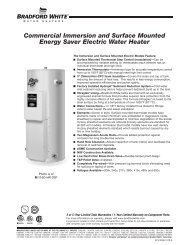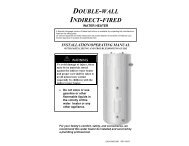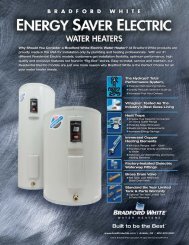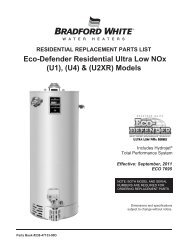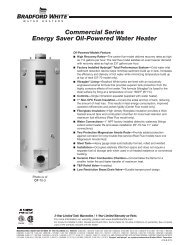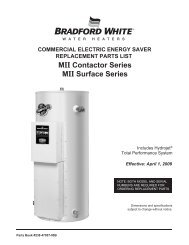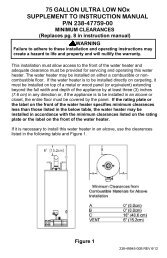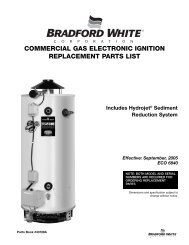238-47104-00A - Bradford White
238-47104-00A - Bradford White
238-47104-00A - Bradford White
Create successful ePaper yourself
Turn your PDF publications into a flip-book with our unique Google optimized e-Paper software.
RESIDENTIAL ELECTRIC AND LIGHT DUTYCOMMERCIAL ELECTRIC WATER HEATERSSERVICEMANUALTroubleshooting Guideand Instructions for Service(To be performed ONLY byqualified service providers)Models Coveredby This Manual:Residential Energy Saver:M1& M2(HE) UprightModels.M1& M2 Lowboy Models.M1& M2 UtilityModels.M1& M2 Wall HungModels.Light DutyEnergy Saver:LD Upright Models.LD Utility Models.LD Lowboy.LD WallHung.Photo is ofM-2-50T6DSDairy Barn Deluxe Energy Saver:DB Models.Manual <strong>238</strong>-<strong>47104</strong>-<strong>00A</strong>Save this manual for future reference
Residential and Light DutyCommercial Electric Water HeatersTable of ContentsIntroduction ………………………………………………………………………. 2Tools……………………………………………………………………………… 2Page Service ProcedureGeneral Information ……………………………………………………………… 3 - - -Sequence of Operation …………………………………………………………… 6 - - -Single Element Operation ……………………………………................... 6 - - -Double Element, Non-Simultaneous, Single Phase………………………. 7 - - -Double Element, Simultaneous, Single Phase, 4 wire Service …............... 8 - - -Double Element, Non-Simultaneous, 3 Phase ………................................ 9 - - -Double Element, Simultaneous, 3 Phase ………………………………… 10 - - -Double Element, Non-Simultaneous, Single Phase, Off Peak …………... 11 - - -Troubleshooting …………………………………………………………………. 12 - - -Line Voltage and High Limit ECO Testing……………………………………… 14 RE-IHeating Element Testing ……………................................................................... 15 RE-IIResidential Thermostat Testing ……..................................................................... 16 RE-IIISingle Element ……………………………............................................... 16Double Element, 4 wire, Simultaneous, Single Phase …………………... 16Double Element, Non-Simultaneous, Single Phase ………....................... 17Double Element, Non-Simultaneous, 3 Phase …………………………... 19Double Element, Simultaneous, 3 Phase ………………………………... 21Double Element, Non-Simultaneous, Single Phase, Off Peak ………….. 23Light Duty Commercial Thermostat Testing …..................................................... 25 RE IVDouble Element, Non-Simultaneous, Single Phase ……………………... 25Double Element, Simultaneous, Single Phase …………………………... 27Double Element, Non-Simultaneous, 3 Phase …………………………... 29Double Element, Simultaneous, 3 Phase ………………………………... 31Thermostat Removal and Replacement …………………………………………. 33 RE-VHeating Element Removal and Replacement ……………………………………. 34RE-VIDip Tube and Anode Inspection and Replacement ……………………………… 35 RE-VIIGeneric Parts List ………………………………………………………………... 36 - - -IntroductionThis service manual is designed to aid service and maintenance professionals on the function, proper diagnosis and repair of<strong>Bradford</strong> <strong>White</strong> residential electric and light duty commercial electric water heaters.The text and illustrations in this manual provide step by step instructions to facilitate proper operation and troubleshootingprocedures. Contact the <strong>Bradford</strong> <strong>White</strong> Technical Support Group immediately if diagnosis can not be made using themethods described in this service manual.Tools- Multi Meter. - Phillips Head Screw Driver.- 1-½ Deep Well Socket (element removal). - Thermometer.- ¼" Nut Driver. - Drain Hose.- Various Hand Tools: Pipe Wrench, Channel Locks, Pliers (common & needle nose), Wire cutters, Wire Strippers,Flash Light.Page 22
GENERAL INFORMATIONCommonly Used FormulasAmps = Watts (for single phase units) Example 4500W/240V = 18.75AVoltsAmps = Watts (for balanced 3 phase units) Example 4500W/240V x 1.732 = 10.82AVolts x 1.732Watts = Amps x Volts Example 18.75A x 240V = 4500WOhms = VoltsWatts22Example (240V) / 4500W = 12.8 OhmsBLACKUngroundedCommon Service Wire Configurations120 VOLT240 VOLTWHITEGrounded(Neutral)GREENGroundingBLACK RED GREENUngrounded Ungrounded Grounding120 0240 120120120Neutral208 3PhA B CNeutral240 3PhA B C480 3Ph/277 1 PhNeutral A B C120120277120120 208208 208120120 240240 240277277 480480 480RED BLACK REDRED BLACK REDPage 3RED BLACK RED3
GENERAL INFORMATIONWattage Limitations at Various VoltagesResidential Electric Upright M1 & M2 Series (Non-Simultaneous operation)Residential High Efficiency Upright M2HE Series (Non-Simultaneous operation)Residential Electric Lowboy M1 & M2 Series (Non-Simultaneous Operation)Dairy Barn Deluxe DB Series (Non-Simultaneous Operation)MaximumWattageElementUpper/LowerVoltage3,000 3,000/3,0001206,000 6,000/6,000 208, 2406,000 6,000/6,000277, 480Residential Electric Upright M1 & M2 Series (Simultaneous Operation)Residential High Efficiency Upright M2HE Series (Simultaneous Operation)Residential Electric Lowboy M1 & M2 Series (Simultaneous Operation)Light Duty Commercial Electric LD Series (Non-Simultaneous Operation)Light Duty Commercial Electric LD Series (Simultaneous Operation)Dairy Barn Deluxe DB Series (Simultaneous Operation)MaximumWattageElementUpper/LowerVoltage3,000 1,500/1,50012010,000 5,000/5,00020811,000 5,500/5,50024012,000 6,000/6,000 277, 480Residential Electric Utility Series (Single Element Operation)Light Duty Utility Series (Single Element Operation)MaximumWattageSingleElementVoltage3,000 3,0001206,000 6,000208, 2406,000 6,0002776,000 6,000480Page 44
GENERAL INFORMATIONSurface Mounted ThermostatsSurface mounted thermostats are mounted into a bracket which holds the thermostat against the side of the tank.Surface mounted thermostats respond to tank surface temperatures to sense a call for heat, set point temperaturesettings and high limit (ECO) activation. It is import that the entire back surface of the thermostat is in full contact or flushwith the tank. Improperly mounted thermostat will lead to improper heater operation.ManualECO (high limit)Reset buttonTemperaturecontrol DialTemperaturecontrol DialSurface MountCombination Thermostat/ECO (high limit)89T SeriesSurface MountCombination Thermostat/ECO (high limit)89T SeriesDirect Immersion “Screw-in” Type Heating ElementSurface MountThermostat59T Series1-½ HexScrew-in FlangeTerminal BlockZinc Plated Copper orIncoloy SheathTerminal BlockScrewElement Rating Ink Stampedon side of Terminal Block.Page 55
SEQUENCE OF OPERATIONResidential and light duty commercial electric water heaters are designed to operate using several different operatingmodes. The common modes and sequence of operation are as follows:1. Single Element Operation.2. Double Element Non-Simultaneous Operation (single phase).3. Double Element Non-Simultaneous Operation (3 phase).4. Double Element Simultaneous Operation (single phase).5. Double Element Simultaneous Operation (3 phase).Sequence of Operation- Single Element Operation.1Line voltage is applied across terminalsL1 &L3 of the thermostat. ECO isclosed, so there is voltage at terminal L4and to one side of the element.1ECOClosed2Tank is cold therefore thermostatis closed at terminal T2 (calling for heat).This completes the circuit and allowscurrent to flow through the element.2Thermostat closedat terminal T23When the thermostat is satisfied, it opens atterminal T2 interrupting current flow through theelement. System is now in stand-by mode, waitingfor the next call for heat.Thermostat opensat terminal T23Page 66
SEQUENCE OF OPERATIONNon-Simultaneous and Simultaneous OperationDouble element electric water heaters are designed to operate in a Non-Simultaneous or Simultaneous mode.Non-Simultaneous Mode: Allows only one heating element to operate at a time. For example, when the tank is cold,the upper element is energized first, heating the top of the tank. Only when the upper thermostat is satisfied, the upperelement is de-energized and power is directed to the lower thermostat, energizing the lower element and heating thebottom portion of the tank until the lower thermostat is satisfied. As hot water is drawn off the tank, it is replaced withcold water delivered through the dip tube to the bottom of the tank. The bottom of the tank cools, the lower thermostatwill call for heat energizing the lower element. If enough hot water is drawn from the tank, the top portion of the tankcools and the upper thermostat will call for heat, de-energizing the lower element and allowing only the top element toenergize until the upper thermostat is satisfied.Simultaneous mode: allows both heating elements to operate at the same time. That is, if either thermostat (upper orlower) is calling for heat, the corresponding heating element is energized independent of the other.Sequence of Operation- Double Element, Non-Simultaneous Operation, Single Phase.1234Line voltage is applied across terminalsL1 & L3 of the upper thermostat. ECO isclosed, so there is voltage at terminal L4and to one side of the upper and lowerelements.Tank is cold therefore both thermostatsare closed at terminal T2 & 2 (calling for heat). Thecircuit is complete through the upper thermostatonly, allowing current to flow through upperelement.When upper thermostat is satisfied, it opens atterminal T2 interrupting current flow through upperelement, and closes at terminal T4 allowing voltageto pass to terminal 1 of lower thermostat. Thiscompletes the circuit through the lower thermostatand allows current flow through lower element.When the lower thermostat is satisfied, it opens atterminal 2 interrupting current flow through lowerelement. The system is now in stand-by modewaiting for the next call for heat1 2UpperT’statUpperElementLowerT’statLowerElementECOClosedThermostat closedat terminal T2Thermostat closedat terminal 2UpperT’statUpperElementLowerT’statLowerElement5The lower thermostat/elementcombination will generallycycle on and off more oftenthen the upper. In some cases,such as a cold tank or in highdemand periods, the upperthermostat will call for heat(opening at terminalT4 and closing atterminal T2) prior to the lowerthermostat being satisfied. Thiswill interrupt current flowthrough the lower thermostatand element and allow currentto flow through the upperelement only. When the upperthermostat is satisfied, itresumes operation asdescribed in sequence #3above.Thermostat closedat terminal T43UpperT’statUpperElementLowerT’statLowerElementThermostat openbetween terminals1 and 24UpperT’statUpperElementLowerT’statLowerElementThermostat closedat terminal T2Thermostat closedbetween terminals1 and 25UpperT’statUpperElementLowerT’statLowerElementPage 77
SEQUENCE OF OPERATIONA 4 wire, double element heater wired for simultaneous operation is essentially two single element systems operatingindependently. The heaters are wired internally with two independent circuits, one circuit for each thermostat/elementcombination. When installed using a two wire service, the blue and red (or white) wires will be connected together,likewise black and yellow wires will be connected together.Sequence of Operation- Double Element, Simultaneous Operation, Single Phase, 4 wire service installation.1Line voltage from circuit one is appliedacross terminals L1 & L3 of the lowerthermostat. Likewise, line voltage fromcircuit two is applied across terminals L1 &L3 of the upper thermostat. ECO in bothupper and lower thermostat is closed, sothere is voltage at terminal L4 of eachthermostat and to one side of the upper andlower elements.Circuit one1Circuit twoECOClosedCircuit one2Thermostat closedat terminal T2Circuit two2Tank is cold therefore both thermostatsare closed at terminal T2 (calling for heat).This completes the circuit through thethermostats and allows current to flowthrough the elements.ECOClosedThermostat closedat terminal T23 Circuit oneWhen either thermostat is satisfied, it willopen at terminal T2, interrupting currentflow through the corresponding element. Asboth thermostats satisfy, the system will bein stand-by mode waiting for the next callfor heat. Thermostats will operateindependent of the other.3Thermostat openat terminal T2Circuit twoThermostat openat terminal T2Page 88
SEQUENCE OF OPERATIONSequence of Operation- Double Element, Non-Simultaneous Operation, 3 Phase.1 21Line voltage is applied across terminals L1& L3 of upper thermostat. Likewise, Linevoltage is applied to terminal L3 of lowerthermostat. ECO in both upper & lowerthermostat is closed, so there is voltage atterminal L4 of both thermostats and to oneside of both upper & lower elements.ECOClosedThermostat closedat terminal T22Tank is cold therefore both thermostatsare closed at terminal T2 (calling for heat).The circuit is complete through the upperthermostat only allowing current to flowthrough the upper element.ECOClosedThermostat closedat terminal T23When the upper thermostat is satisfied, itopens at terminal T2 interrupting currentflow through upper element, and closes atterminal T4 allowing voltage to pass toterminal L1 of lower thermostat. Thiscompletes the circuit through the lowerthermostat allowing current flow throughlower element.Thermostat closedat terminal T43Thermostat closedat terminal T444When the lower thermostat is satisfied, itopens at terminal T2 interrupting thecurrent flow through the lower element. Thesystem is now in stand-by mode waiting forthe next call for heat.5The lower thermostat/element combinationwill generally cycle on and off more oftenthen the upper. In some cases, such as acold tank or in high demand periods, theupper thermostat will call for heat (openingat terminal T4 and closing at terminal T2)prior to the lower thermostat being satisfied.This will interrupt current flow through thelower thermostat and element and allowcurrent to flow through the upper elementonly. When the upper thermostat issatisfied, it resumes operation as describedin sequence #3 above.Thermostat closedat terminal T2Thermostat closedat terminal T25Thermostat openat terminal T2Thermostat closedat terminal T2Page 99
SEQUENCE OF OPERATIONSequence of Operation- Double Element, Simultaneous Operation, 3 Phase.1Line voltage is applied across terminals L1& L3 of upper thermostat. Line voltage alsoextends to terminal L1 of lower thermostat.Also, line voltage is applied to terminal L3of lower thermostat. ECO in both upper &lower thermostat is closed, so there isvoltage at terminal L4 of both thermostatsand to one side of both upper & lowerelements.1 2ECOClosedThermostat closedat terminal T22Tank is cold therefore both thermostatsare closed at terminal T2 (calling for heat).This completes the circuit through thethermostats and allows current to flowthrough the elements.ECOClosedThermostat closedat terminal T23When either thermostat is satisfied, it willopen at terminal T2, interrupting currentflow through the corresponding element. Asboth thermostats satisfy, the system will bein stand-by mode waiting for the next callfor heat. Thermostats will operateindependent of the other.Thermostat openat terminal T23Thermostat openat terminal T2Page 1010
SEQUENCE OF OPERATIONSome electric utility companies will offer discounts for using electricity during “Off Peak” Times of the day. The systemallows the use of an “Off Peak” meter, which interrupts power to the lower element during high power demand periods.Sequence of Operation- Double Element, Non-Simultaneous Operation, Single Phase, Off Peak.12Line voltage is applied across terminalsL1 & L3 of the upper thermostat. Line voltage fromoff peak meter is supplied to terminal L1 of lowerthermostat. ECO in the upper thermostat is closed,so there is voltage at terminal L4 of upperthermostat and to one side of the upper element.Tank is cold therefore both thermostatsare closed at terminal T2 (calling for heat). Thecircuit is complete through the upper thermostatonly, allowing current to flow through upperelement.FromOff PeakMeter1 2ECOClosedThermostat closedat terminal T23When upper thermostat is satisfied, it opens atterminal T2 interrupting current flow through upperelement, and closes at terminal T4 allowing voltageto pass to one side of the lower element. Thiscompletes the circuit through the lower thermostatand off peak meter allowing current flow throughlower element.Thermostat closedat terminal T24When the lower thermostat is satisfied, it opens atterminal T2 interrupting current flow through lowerelement. The system is now in stand-by modewaiting for the next call for heat5During peak power demand periods as determinedby the local utility, the off peak meter will interruptpower to terminal L1 of lower thermostat. Only thetop thermostat/element combination is allowed tooperate during this period.FromOff PeakMeter34 5Off PeakPower interruptedThermostat closedat terminal T4Thermostat closedat terminal T2Thermostat closedat terminal T2Thermostat openat terminal T2Page 1111
TROUBLESHOOTINGMost common cause for improper electric water heater operation can be linked to heating elementfailure.When troubleshooting an electric water heater with the incidence of “No Hot Water” or “Insufficient Amount of HotWater” Its always a good idea to check the heating elements first following the procedure on page 15.Common Heating Element Failures Are:1. Dry Firing. Element may be partially submerged in water or most likely, completely exposed with no water intank. In some cases sediment or lime build up around an element can eventually cause an air pocket, andwithin seconds, result in a dry fired element. At this point the element becomes inoperative. When elementreplacement is required, be sure tank is full of water prior to energizing the water heater.2. Grounded Element. An element with a short circuit to ground will in most cases cause the circuit breaker inthe service panel to open or shut off. In some cases there may not be enough current draw for the circuitbreaker to open. This will allow the heating element to be in continuous operation resulting in over heatedwater, limited only by the ECO or Energy Cut Off located in the thermostat. Repeated actuation of the ECOreset button on the thermostat usually is the result of a grounded element.3. Sediment build up. Slow hot water recovery can usually be traced back to sediment or lime build up aroundheating element. Sediment build up can also over time cause a dry fired element.Illustration 1, below shows a common “Screw-In” type heating element identifying certain features commonly referredto throughout this manual.1-½ HexScrew-in FlangeTerminal BlockZinc Plated Copper orIncoloy Sheath06424500W 240VRC02404524Terminal BlockScrewElement Rating Ink Stampedon side of Terminal Block.Illustration 1Typical Direct Immersion “Screw-In”Type Heating ElementPage 1212
TROUBLESHOOTINGQuick Step Plan to Hot Water1. TURN OFF power to water heater and check all wireconnections to insure they are tight and corrosion free.2. Turn power “ON” and determine that service voltage ispresent, and the high limit (ECO) has not actuated(see procedure on page 14).WARNINGHigh voltage exposure. Use caution whenmaking voltage checks to avoid personalinjury.3. Check for inoperative heating element (see procedure on page 15).4. Check for proper thermostat operation (see procedures beginning on page 16). NOTE: Thermostat testing proceduresassume items 2 and 3 above are in working order.SYMPTOM PROBABLE CAUSE CORRECTIVE ACTIONSERVICEPROCEDURENo Hot Water1. No Power to heater.2. Loose wire connections.3. Inoperative upper heating element.4. Inoperative upper thermostat.5. Open ECO.1. Check fuses or circuit breakers in servicepanel.2. Check all wire connections.3. Check heating element(s). Replace asneeded.4. Check thermostat(s) operation. Replace asneeded.5. Check ECO. Reset or replacethermostat(s) as needed.3. See Service ProcedureRE-II, Page 15.4. See Service ProcedureRE-III, Page 16.5. See Service ProcedureRE-I, Page 14.Not Enough HotWaterSlow Hot WaterRecovery1. Inoperative lower heating element.2. Thermostat(s) set to low.3. Inoperative thermostat(s).4. Loose wire connection.5. Sediment or lime build up on element(s).6. High demand period.7. Undersized heater.8. Very cold inlet water to heater.9. Plumbing connections reversed.10. Damaged dip tube.1. Sediment or lime build up on element(s).2. Loose wire connections.3. Inoperative thermostat(s).4. Derated heating element installed.1. Check heating element(s), replace asneeded.2. Increase thermostat setting.3. Check thermostat(s), replace as needed.4. Check all wire connection.5. Remove heating element(s) and check forlime build up.6. Reduce demand.7. Replace with larger heater.8. Temper water to heater.9. Correct plumbing connections.10. Check dip tube, replace as needed.1. Remove heating element(s) and check forlime build up.2. Check all wire connections.3. Check thermostat(s), replace as needed.4. Check terminal block of element for propervoltage and wattage rating.1. See Service ProcedureRE-II, Page 15.3. See Service ProcedureRE-III, Page 16.5. See Service ProcedureRE-VI, Page 34.10. See Service ProcedureRE-VII, Page 35.1. See Service ProcedureRE-VI, Page 34.3. See Service ProcedureRE-III, Page 16.Over HeatedWater orContinuesOperation1. Thermostat not in contact with tank.2. Grounded heating element(s).3. Thermostat set to high.4. Inoperative thermostat(s).5. Inoperative ECO.6. Undersized water heater.1. Position thermostat flush with tank surface.2. Check heating element(s). Replace asneeded.3. Adjust thermostat(s) to desired setting.4. Check thermostat(s), replace as needed.5. Check ECO, replace thermostat asneeded.6. Replace with larger heater.1. See Service ProcedureRE-V, Page 33.2. See Service ProcedureRE-II, Page 15.4. See Service ProcedureRE-III, Page 16.5. See Service ProcedureRE-I, Page 14.Noisy (singing orhissing) Elements1. Lime formation on elements. 1. Remove and clean heating elements.Replace as needed.1. See Service ProcedureRE-VI, Page 34.Page 1313
SERVICE PROCEDURE RE-ILine Voltage & High Limit (ECO)TestingLine Voltage Testing1. Turn “OFF” power to water heater.2. Remove access cover(s) from front of waterheater. Remove insulation and plastic coverfrom thermostat.3. Set multi-meter to volts AC.WARNINGHigh voltage exposure. Use caution whenmaking voltage checks to avoid personal injury.ECO resetbutton4. Turn power “ON” to water heater.5. Check voltage across terminals L1 & L3of upper thermostat (see illustration 2).A) Rated voltage IS present, power to the waterheater is okay.B) Rated voltage NOT present, Check circuit breakerat service panel.Illustration 2 Illustration 3High Limit (ECO) Testing1. Check voltage across terminals L1 & L4 upper thermostat (see illustration 3).A) Rated Voltage IS present, ECO is okay.B) Rated voltage NOT present, proceed to step 2.2. Turn power “OFF” to water heater and firmly press ECO reset button on thermostat(s). Turn power “ON” and recheckvoltage across terminals L1 & L4 of upper thermostat(see illustration 3).A) Rated voltage IS present, the ECO has opened indicating the water in the tank is or has over heater.Check the following:1. Thermostat must be in full contact with tank.2. Be sure heating element(s) is not shorted to ground (see page 15).3. Proper thermostat operation (see procedures beginning on page 16).B) Rated voltage NOT present, water in tank may be over heated.1. If water is hot, turn “OFF” power to water heater and flow water through tank to cool below set pointof upper thermostat. Recheck voltage per step 1.2. If water is cool, Replace upper thermostat.Page 1414
SERVICE PROCEDURE RE-IIHeating Element TestingTesting For Open Or Burned Out Element.Step 1. TURN OFF POWER TO WATER HEATER.Step 2. Remove access cover(s) from front of waterheater. Remove insulation and plastic coverfrom thermostat.WARNINGHigh voltage exposure. Be sure power is turnedOFF to water heater prior to performing thisprocedure.Step 3. Disconnect wires from heating element.Step 4. Set multi-meter to “ohms” setting.Step 5. Touch probes of multi-meter to screwterminals of heating element(see illustration 4).Step 6. Reading should be 12.8 ohms (±6%) for a 240volt, 4500 watt element:Ohms = Volts 2WattsA reading outside the range using the formulaabove (±6%), indicates a bad element and theelement must be replaced.Meter ProbeElement Screw TerminalsIllustration 4Testing For Heating Element Short Circuit ToGround.Step 1. TURN OFF POWER TO WATER HEATER.Step 2. Remove access cover(s) from front of waterheater. Remove insulation and plastic coverfrom thermostat.Step 3. Disconnect wires from heating element.Step 4. Set multi-meter to “ohms” setting.Step 5. Touch one probe of multi-meter to either screwterminal of heating element and the other onthe element flange (see illustration 5). Thereshould be no reading on the ohm meter. Anyreading indicates a grounded element and theelement must be replaced. Repeat this step forthe other screw terminal.Element Screw TerminalMeter ProbeElement FlangeIllustration 5Page 1515
SERVICE PROCEDURE RE-IIIResidential Thermostat TestingSingle Element Operation orDouble Element, 4 Wire, Simultaneous, Single PhaseOperation.WARNINGHigh voltage exposure. Use caution to avoidpersonal injury during this procedure.Water In Tank Is Cold With Power ON.1. This procedure assumes line voltage, ECO andelements are in working order.2. Turn power “ON” to water heater.3. Set multi-meter to “Volts AC”.4. Check across terminals L4 and T2 ofthermostat (see illustration 6).A) Rated voltage NOT present,Recheck ECO. If ECO is okay,replace thermostat.B) Rated voltage IS present,proceed to next step.5. Check across element terminals(see illustration 7).A) Rated voltage NOT present,check wire connections fromthermostat to element.B) Rated voltage IS present,Repeat element testingsee page 15.Illustration 6Illustration 7Water Temperature In Tank Is Above Thermostat Setting.1. This procedure assumes line voltage, ECO andelements are in working order.2. Turn power “ON” to water heater.3. Set multi-meter to “Volts AC”.4. See illustration 6 above, check across terminals L4 and T2of thermostat.A) Rated voltage IS present,replace thermostat.B) Rated voltage NOT present,thermostat is okay.C) Lower than rated voltage IS present,recheck for grounded element(see page 15).Reference 4 Wire, Simultaneous, Single PhaseWiring diagram.NOTE: Wiring consists of two single element configurationsoperating independently.Page 1616
SERVICE PROCEDURE RE-IIIResidential Thermostat TestingDouble Element, Non-Simultaneous, Single PhaseOperation.WARNINGHigh voltage exposure. Use caution to avoidpersonal injury during this procedure.Water In Tank Is Cold With Power ON.1. This procedure assumes line voltage, ECO andelements are in working order.2. Turn power “ON” to water heater.3. Set multi-meter to “Volts AC”.4. Check across terminals L4 and T2 ofupper thermostat (see illustration 8).A) Rated voltage NOT present,Recheck ECO. If ECO is okay,replace thermostat.B) Rated voltage IS present,proceed to next step.5. Check across element terminals(see illustration 9).A) Rated voltage NOT present,check wire connections fromthermostat to element.B) Rated voltage IS present,Repeat element testingsee page 15.Illustration 8Illustration 9Tank Does Not Deliver Enough Hot Water.1. This procedure assumes line voltage, ECO andelements are in working order.2. Turn power “ON” to water heater and set multi-meter to “Volts AC”.3. Adjust temperature setting of upper thermostat to the highest setting.Water temperature in tank must be below thermostat setting for this test.4. See illustration 8 above, check voltage across terminals L4 and T2 of upperthermostat.A) Rated voltage IS present, okay, upper thermostat iscalling for heat. Go to step 5 below.B) Rated voltage NOT present, replace upper thermostat.5. Adjust temperature setting of upper thermostat to the minimum setting.Water temperature in tank must be above thermostat setting for this test.6. Check voltage across terminals L4 and T4 of upper thermostat(see illustration 10).A) Rated voltage NOT present, replace upper thermostat.B) Rated voltage IS present, thermostat is okay. Go to step 7 on next page.Illustration 10Page 1717
SERVICE PROCEDURE RE-IIIResidential Thermostat TestingDouble Element, Non-Simultaneous, Single PhaseOperation (continued).WARNINGHigh voltage exposure. Use caution to avoidpersonal injury during this procedure.Not Enough Hot Water (continued).7. Check voltage across terminal L4 of upperthermostat and terminal 1 of lower thermostat(see illustration 11).A) Rated voltage NOT present,- check wire connection between thermostats.B) Rated voltage IS present, okay, go to step 8.8. Adjust lower thermostat to highest setting. Water temperature intank must be below the lower thermostat setting for this test.9. Check voltage across terminal L4 of upperthermostat and terminal 2 of lower thermostat (see illustration 12).A) Rated voltage NOT present, replace lower thermostat.B) Rated voltage IS present, thermostat is ok.WARNINGBe sure thermostats are reset to their originaltemperature settings as found prior tothermostat testingIllustration 11Water Temperature In Tank Is Above Thermostat Setting.1. This procedure assumes Line voltage, ECO and elements are in workingorder.2. Adjust upper and lower thermostats to the lowest setting.3. Turn power “ON” to water heater and set multi-meter to “Volts AC”.4. Check across terminals L4 and T2 of upper thermostat(see illustration 8 on page 17).A) Rated voltage IS present, replace upper thermostat.B) Rated voltage NOT present, upper thermostat is okay. Go to step5 below.C) Lower than rated voltage IS present, recheck for grounded upperelement (see page 15).5. Check across terminals L4 and 2 of lower thermostat (see illustration 12).A) Rated voltage IS present, replace lower thermostat.B) Rated voltage NOT present, lower thermostat is okay.Illustration 12C) Lower than rated voltage IS present, recheck for grounded lowerelement (see page 15).Page 1818
SERVICE PROCEDURE RE-IIIResidential Thermostat TestingDouble Element, Non-Simultaneous, Three PhaseOperation.Water In Tank Is Cold With Power ON.WARNINGHigh voltage exposure. Use caution to avoidpersonal injury during this procedure.1. This procedure assumes line voltage, ECO andelements are in working order.2. Turn power “ON” to water heater.3. Set multi-meter to “Volts AC”.4. Check across terminals L4 and T2 ofupper thermostat (see illustration 13).A) Rated voltage NOT present,Recheck ECO. If ECO is okay,replace thermostat.B) Rated voltage IS present,proceed to next step.5. Check across element terminals(see illustration 14).A) Rated voltage NOT present,check wire connections fromthermostat to element.B) Rated voltage IS present,Repeat element testing,see page 15.Illustration 13 Illustration 14Tank Does Not Deliver Enough Hot Water.1. This procedure assumes line voltage, ECO andelements are in working order.2. Turn power “ON” to water heater and set multi-meter to “Volts AC”3. Adjust temperature setting of upper thermostat to the highest setting.Water temperature in tank must be below thermostat setting for this test.4. See illustration 13 above, check voltage across terminals L4 & T2 of upperthermostat.A) Rated voltage IS present, okay, upper thermostat iscalling for heat. Go to step 5 below.B) Rated voltage NOT present, replace upper thermostat.5. Adjust temperature setting of upper thermostat to the minimum setting.Water temperature in tank must be above thermostat setting for this test.6. Check voltage across terminals T4 of upper thermostat & L3 of lower thermostat(see illustration 15).A) Rated voltage NOT present, replace upper thermostat.B) Rated voltage IS present, upper thermostat is okay. Go to step 7 on nextpage.Illustration 15Page 1919
SERVICE PROCEDURE RE-IIIResidential Thermostat TestingDouble Element, Non-Simultaneous,Three Phase Operation (continued).WARNINGHigh voltage exposure. Use caution to avoidpersonal injury during this procedure.Tank Does Not Deliver Enough Hot Water (continued)7. Check voltage across terminal L1 & L3 of lower thermostat (see illustration 16).A) Rated voltage NOT present, check wire connection between thermostats.B) Rated voltage is present, okay, go to step 8.8. Adjust lower thermostat to highest setting. Water temperature in tank must be belowthe lower thermostat setting for this test.9. Check voltage across terminal L4 & T2 of lower thermostat (see illustration 17).A) Rated voltage NOT present, recheck ECO (see page 14). If ECO okay,replace lower thermostat.B) Rated voltage IS present, thermostat is ok. Check wire connection to lowerelement. If connection okay, recheck lower element (see page 15).WARNINGBe sure thermostats are reset to their originaltemperature settings as found prior tothermostat testingIllustration 16Water Temperature In Tank Is Above Thermostat Setting.1. This procedure assumes Line voltage, ECO and elements are in workingorder.2. Adjust upper and lower thermostats to the lowest setting.3. Turn power “ON” to water heater and set multi-meter to “Volts AC”.4. Check across terminals L4 and T2 of upper thermostat(see illustration 13 on page 19).A) Rated voltage IS present, replace upper thermostat.B) Rated voltage NOT present, upper thermostat is okay. Go to step5 below.C) Lower than rated voltage IS present, recheck for grounded upperelement (see page 15).5. Check across terminals L4 and T2 of lower thermostat (see illustration 17).A) Rated voltage IS present, replace lower thermostat.B) Rated voltage NOT present, lower thermostat is okay.C) Lower than rated voltage IS present, recheck for grounded lowerelement (see page 15).Page 20Illustration 1720
SERVICE PROCEDURE RE-IIIResidential Thermostat TestingDouble Element, Simultaneous, Three PhaseOperation.WARNINGHigh voltage exposure. Use caution to avoidpersonal injury during this procedure.Water In Tank Is Cold Or Not Enough HotWater With Power ON.1. This procedure assumes line voltage,ECO and elements are in working order.2. Adjust temperature setting for boththermostats to the highest setting.2. Turn power “ON” to water heater.3. Set multi-meter to “Volts AC”.4. Check across terminals L4 and T2 ofupper thermostat (see illustration 18).A) Rated voltage NOT present,Recheck ECO (see page 14).If ECO is okay, replacethermostat.B) Rated voltage IS present,proceed to next step.5. Check across upper element terminals(see illustration 19).A) Rated voltage NOT present,check wire connections fromthermostat to element.B) Rated voltage IS present,Repeat element testingsee page 15.6. Check across terminals L1 & L3 oflower thermostat (see illustration 20).A) Rated voltage NOT present,check wire connections fromupper to lower thermostats.B) Rated voltage IS present,okay, go to step 7.7. Check across terminals L4 and T2 oflower thermostat (see illustration 21).A) Rated voltage NOT present,Recheck ECO (see page 14). IfECO is okay, replace thermostat.B) Rated voltage IS present,proceed to next step.8. Check across lower element terminals.A) Rated voltage NOT present,check wire connections fromthermostat to element.B) Rated voltage IS present,Repeat element testingsee page 15.Illustration 18 Illustration 19Illustration 20 Illustration 21WARNINGBe sure thermostats are reset to their originaltemperature settings as found prior tothermostat testingPage 2121
SERVICE PROCEDURE RE-IIIResidential Thermostat TestingDouble Element, Simultaneous, Three PhaseOperation (continued).WARNINGHigh voltage exposure. Use caution to avoidpersonal injury during this procedure.Water Temperature In Tank Is Above ThermostatSetting.1. This procedure assumes Line voltage, ECO andelements are in working order.2. Adjust upper and lower thermostat to the lowest setting.3. Turn power “ON” to water heater.4. Set multi-meter to “Volts AC”.5. Check across terminals L4 and T2 ofupper thermostat (see illustration 22).A) Rated voltage IS present,replace upper thermostat.B) Rated voltage NOT present,upper thermostat is okay. Go to step 6 below.C) Lower than rated voltage IS present,recheck for grounded upper element(see page 15).Illustration 226. Check across terminals L4 and T2 oflower thermostat (see illustration 23).A) Rated voltage IS present,replace lower thermostat.B) Rated voltage NOT present,lower thermostat is okay.C) Lower than rated voltage IS present,recheck for grounded lower element(see page 15).Illustration 23Page 2222
SERVICE PROCEDURE RE-IIIResidential Thermostat TestingDouble Element, Non-Simultaneous, Single Phase,Off Peak Operation.WARNINGHigh voltage exposure. Use caution to avoidpersonal injury during this procedure.Water In Tank Is Cold With Power ON.1. This procedure assumes line voltage,ECO and elements are in working order.2. Turn power “ON” to water heater.3. Set multi-meter to “Volts AC”.4. Check across terminals L4 and T2 ofupper thermostat (see illustration 24).A) Rated voltage NOT present,Recheck ECO (see page 14).If ECO is okay, replace thermostat.B) Rated voltage IS present,proceed to next step.5. Check across element terminals(see illustration 25).A) Rated voltage NOT present,check wire connections fromthermostat to element.B) Rated voltage IS present,Repeat element testingsee page 15. Illustration 24 Illustration 25Tank Does Not Deliver Enough Hot Water.1. This procedure assumes line voltage, ECO and elements are inworking order. Be sure OFF PEAK meter has not interruptedline voltage.2. Turn power “ON” to water heater and set multi-meter to “Volts AC”.3. Adjust temperature setting of upper & lower thermostat to theHighest setting. Water temperature in tank must be below thermostatsetting for this test.4. See illustration 24 above. Check voltage across terminals L4 & T2 ofupper thermostat.A) Rated voltage IS present, okay, upper thermostat is callingfor heat. Go to step 5 below.B) Rated voltage NOT present, replace upper thermostat.5. Adjust temperature setting of upper thermostat to the minimumsetting. Water temperature in tank must be above thermostat settingfor this test.6. Check voltage across terminals T4 of upper thermostat & L1 of lowerthermostat (see illustration 26).A) Rated voltage NOT present, replace upper thermostat.B) Rated voltage IS present, upper thermostat is okay. Go tostep 7 on next page. Illustration 26Page 2323
SERVICE PROCEDURE RE-IIIResidential Thermostat TestingDouble Element, Non-Simultaneous,Single Phase, Off Peak Operation.(continued)WARNINGHigh voltage exposure. Use caution to avoidpersonal injury during this procedure.Not Enough Hot Water (continued).7. Check voltage across terminal T4 of upperthermostat & T2 of lower Thermostat.(see illustration 27).A) Rated voltage NOT present,Replace lower thermostat.B) Rated voltage is present, okay,go to step 8.8. Check voltage across lower element(see illustration 28).A) Rated voltage NOT present,Check wire connections betweenthermostats & element.B) Rated voltage IS present,Repeat element testingsee page 15.WARNINGBe sure thermostats are reset to their originaltemperature settings as found prior tothermostat testingIllustration 27 Illustration 28Water Temperature In Tank Is Above Thermostat Setting.1. This procedure assumes Line voltage, ECO and elements are in working order.2. Adjust upper and lower thermostats to the lowest setting.3. Turn power “ON” to water heater and set multi-meter to “Volts AC”.4. Check across terminals L4 and T2 of upper thermostat (see illustration 24 on page 23).A) Rated voltage IS present, replace upper thermostat.B) Rated voltage NOT present, upper thermostat is okay. Go to step 5 below.C) Lower than rated voltage IS present, recheck for grounded upper element (see page 15).5. Check across terminals T4 of upper thermostat and T2 of lower thermostat (see illustration 27 above).A) Rated voltage IS present, replace lower thermostat.B) Rated voltage NOT present, lower thermostat is okay.C) Lower than rated voltage IS present, recheck for grounded lower element (see page 15).Page 2424
SERVICE PROCEDURE RE-IVLight Duty CommercialThermostat TestingDouble Element, Non-Simultaneous, Single PhaseOperation.WARNINGHigh voltage exposure. Use caution to avoidpersonal injury during this procedure.Water In Tank Is Cold With Power ON.1. This procedure assumes line voltage, ECO andelements are in working order.2. Turn power “ON” to water heater.3. Set multi-meter to “Volts AC”.4. Check across terminals L4 and T2 ofupper thermostat (see illustration 29).A) Rated voltage NOT present,Recheck ECO (see page 14). IfECO is okay, replace thermostat.B) Rated voltage IS present,proceed to next step.5. Check across element terminals(see illustration 30).A) Rated voltage NOT present,check wire connections fromthermostat to element.B) Rated voltage IS present,Repeat element testingsee page 15. Illustration 29 Illustration 30Tank Does Not Deliver Enough Hot Water.1. This procedure assumes line voltage, ECO and elements are inworking order.2. Turn power “ON” to water heater and set multi-meter to “Volts AC”3. Adjust temperature setting of upper & lower thermostat to theHighest setting. Water temperature in tank must be below thermostatsetting for this test.4. See illustration 29 above. Check voltage across terminals L4 & T2 ofupper thermostat.A) Rated voltage IS present, okay, upper thermostat is callingfor heat. Go to step 5 below.B) Rated voltage NOT present, replace upper thermostat.5. Adjust temperature setting of upper thermostat to the minimumsetting. Water temperature in tank must be above thermostat settingfor this test.6. Check voltage across terminals L3 & T4 of upperthermostat (see illustration 31).A) Rated voltage NOT present, replace upper thermostat.B) Rated voltage IS present, upper thermostat is okay. Go tostep 7 on next page.Illustration 31Page 2525
SERVICE PROCEDURE RE-IVLight Duty CommercialThermostat TestingDouble Element, Non-Simultaneous,Single Phase Operation (continued)WARNINGHigh voltage exposure. Use caution to avoidpersonal injury during this procedure.Tank Does Not Deliver Enough HotWater (continued).7. Check voltage across terminal L3 of upperthermostat & T2 of lower Thermostat.(see illustration 32).A) Rated voltage NOT present,Replace lower thermostat.B) Rated voltage is present, okay,go to step 8.8. Check voltage across lower element(see illustration 33).A) Rated voltage NOT present,Check wire connections betweenthermostats & element.B) Rated voltage IS present,Repeat element testingsee page 15.WARNINGBe sure thermostats are reset totheir original temperature settingsas found prior to thermostattestingIllustration 32 Illustration 33Water Temperature In Tank Is Above Thermostat Setting.1. This procedure assumes line voltage, ECO and elements are in working order.2, Adjust upper and lower thermostat to the lowest setting.3. Turn power “ON” to water heater and Set multi-meter to “Volts AC”4. See illustration 32 above. Check across terminal L3 of upper thermostat& T2 of lower thermostat.A) Rated voltage IS present, replace lower thermostat.B) Rated voltage NOT present, okay, go to step 5 below.C) Lower than rated voltage IS present, recheck for grounded lowerelement see page 15.5. Check across terminal L4 & T2 of upper thermostat (see illustration 34).A) Rated voltage IS present, replace upper thermostat.B) Rated voltage NOT present, upper thermostat is okay.C) lower than rated voltage IS present, recheck for grounded upperelement see page 15.Illustration 34Page 2626
SERVICE PROCEDURE RE-IVLight Duty CommercialThermostat TestingDouble Element, Simultaneous, Single PhaseOperation.WARNINGHigh voltage exposure. Use caution to avoidpersonal injury during this procedure.Water In Tank Is Cold Or Not Enough HotWater With Power ON.1. This procedure assumes line voltage,ECO and elements are in working order.2. Adjust temperature setting for boththermostats to the highest setting.3. Turn power “ON” to water heater.4. Set multi-meter to “Volts AC”5. Check across terminals L4 and T2 ofupper thermostat (see illustration 35).A) Rated voltage NOT present,Recheck upper ECO(see page 14). If ECOis okay, replace upper thermostat.B) Rated voltage IS present,proceed to next step.6. Check across upper element terminals(see illustration 36).A) Rated voltage NOT present,check wire connections fromthermostat to upper element.B) Rated voltage IS present,Repeat element testingsee page 15.7. Check across terminal L3 of upper thermostatand T2 of lower thermostat (see illustration 37).A) Rated voltage NOT present,Check ECO (see page 14) & wireconnections at upper & lowerthermostats. If okay,replace lower thermostat.B) Rated voltage IS present,proceed to next step.8. Check across lower element terminals(see illustration 38).A) Rated voltage NOT present,check lower element wireconnections to the thermostats.B) Rated voltage IS present,Repeat lower element testingsee page 15WARNINGBe sure thermostats are reset totheir original temperature settingsas found prior to thermostattestingIllustration 35 Illustration 36Illustration 37 Illustration 38Page 2727
SERVICE PROCEDURE RE-IVLight Duty CommercialThermostat TestingDouble Element, Simultaneous, Single PhaseOperation (continued)WARNINGHigh voltage exposure. Use caution to avoidpersonal injury during this procedure.Water Temperature In Tank Is Above ThermostatSetting.1. This procedure assumes line voltage, ECO andelements are in working order.2. Adjust upper and lower thermostat to the lowest setting.3. Turn power “ON” to water heater.4. Set multi-meter to “Volts AC”5. Check across terminals L4 and T2 ofupper thermostat (see illustration 39).A) Rated voltage IS present,replace upper thermostat.B) Rated voltage NOT present,upper thermostat is okay. Go to step 6 below.C) lower than rated voltage IS present,recheck for grounded upper elementsee page 15.6. Check across terminal L3 of upper thermostat andT2 of lower thermostat (see illustration 40).Illustration 39A) Rated voltage IS present,replace lower thermostat.B) Rated voltage NOT present,lower thermostat is okay.C) lower than rated voltage IS present,recheck for grounded lower elementsee page 15.Illustration 40Page 2828
SERVICE PROCEDURE RE-IVLight Duty CommercialThermostat TestingDouble Element, Non-Simultaneous, Three PhaseOperation.Water In Tank Is Cold With Power ON.1. This procedure assumes line voltage, ECO andelements are in working order.2. Turn power “ON” to water heater.3. Set multi-meter to “Volts AC”4. Check across terminals L4 and T2 ofupper thermostat (see illustration 41).A) Rated voltage NOT present,Recheck upper ECO. If ECO is okay,replace thermostat.B) Rated voltage IS present,proceed to next step.5. Check across element terminals(see illustration 42).A) Rated voltage NOT present,check wire connections fromthermostat to element.B) Rated voltage IS present,Repeat element testingsee page 15.WARNINGHigh voltage exposure. Use caution to avoidpersonal injury during this procedure.Illustration 41 Illustration 42Tank Does Not Deliver Enough Hot Water.1. This procedure assumes line voltage, ECO and elements are inworking order.2. Turn power “ON” to water heater and set multi-meter to “Volts AC”3. Adjust temperature setting of upper & lower thermostat to theHighest setting. Water temperature in tank must be below thermostatsetting for this test.4. See illustration 41 above. Check voltage across terminals L4 & T2 ofupper thermostat.A) Rated voltage IS present, okay, upper thermostat is callingfor heat. Go to step 5 below.B) Rated voltage NOT present, replace upper thermostat.5. Adjust temperature setting of upper thermostat to the minimumsetting. Water temperature in tank must be above thermostat settingfor this test.6. Check voltage across terminals L3 & T4 of upperthermostat (see illustration 43).A) Rated voltage NOT present, replace upper thermostat.B) Rated voltage IS present, upper thermostat is okay. Go tostep 7 on next page. Illustration 43Page 2929
SERVICE PROCEDURE RE-IVLight Duty CommercialThermostat TestingDouble Element, Non-Simultaneous,Three Phase Operation (continued).WARNINGHigh voltage exposure. Use caution to avoidpersonal injury during this procedure.Tank Does Not Deliver Enough Hot Water(continued).7. Check voltage across terminal L1 of upperthermostat & T2 of lower Thermostat.(see illustration 44).A) Rated voltage NOT present,Replace lower thermostat.B) Rated voltage is present, okay,go to step 8.8. Check voltage across lower element(see illustration 45).A) Rated voltage NOT present,Check wire connections betweenthermostats & element.B) Rated voltage IS present,Repeat element testingsee page 15.WARNINGBe sure thermostats are reset totheir original temperature settingsas found prior to thermostattestingIllustration 44 Illustration 45Water Temperature In Tank Is Above Thermostat Setting.1. This procedure assumes line voltage, ECO and elements are in working order.2. Adjust upper and lower thermostat to the lowest setting.3. Turn power “ON” to water heater and Set multi-meter to “Volts AC”.4. See illustration 44 above. Check across terminal L1 of upper thermostat& T2 of lower thermostat.A) Rated voltage IS present, replace lower thermostat.B) Rated voltage NOT present, okay, go to step 5 below.C) lower than rated voltage IS present, recheck for grounded lowerelement.5. Check across terminal L4 & T2 of upper thermostat (see illustration 46).A) Rated voltage IS present, replace upper thermostat.B) Rated voltage NOT present, upper thermostat is okay.C) lower than rated voltage IS present, recheck for grounded upperelement, see page 15.Page 30Illustration 4630
SERVICE PROCEDURE RE-IVLight Duty CommercialThermostat TestingDouble Element, Simultaneous, Three PhaseOperation.Water In Tank Is Cold Or Not Enough HotWater With Power ON.1. This procedure assumes line voltage,ECO and elements are in working order.2. Adjust temperature setting for boththermostats to the highest setting.3. Turn power “ON” to water heater.4. Set multi-meter to “Volts AC”5. Check across terminals L4 and T2 ofupper thermostat (see illustration 47).A) Rated voltage NOT present,Recheck upper ECO(see page 14). If ECOis okay, replace upper thermostat.B) Rated voltage IS present,proceed to next step.6. Check across upper element terminals(see illustration 48).A) Rated voltage NOT present,check wire connections fromthermostat to upper element.B) Rated voltage IS present,Repeat element testingsee page 157. Check across terminal L4 of upper thermostatand T2 of lower thermostat (see illustration 49).A) Rated voltage NOT present,Check ECO (see page 14) & wireconnections at upper & lowerthermostats. If okay, replacelower thermostat.B) Rated voltage IS present,proceed to next step.8. Check across lower element terminals(see illustration 50).A) Rated voltage NOT present,check lower element wireconnections to thermostat.B) Rated voltage IS present,Repeat lower element testingsee page 15.WARNINGHigh voltage exposure. Use caution to avoidpersonal injury during this procedure.Illustration 47 Illustration 48WARNINGBe sure thermostats are reset totheir original temperature settingsas found prior to thermostattestingIllustration 49Page 31Illustration 5031
SERVICE PROCEDURE RE-IVLight Duty CommercialThermostat TestingDouble Element, Simultaneous, Three PhaseOperation (continued).WARNINGHigh voltage exposure. Use caution to avoidpersonal injury during this procedure.Water Temperature In Tank Is Above ThermostatSetting.1. This procedure assumes line voltage, ECO andelements are in working order.2. Adjust upper and lower thermostat to the lowest setting.3. Turn power “ON” to water heater.4. Set multi-meter to “Volts AC”5. Check across terminals L4 and T2 ofupper thermostat (see illustration 51).A) Rated voltage IS present,replace upper thermostat.B) Rated voltage NOT present,upper thermostat is okay. Go to step 6 below.C) lower than rated voltage IS present,recheck for grounded upper elementsee page 15.6. Check across terminals L4 & T2 of lower thermostat(see illustration 52).Illustration 51A) Rated voltage IS present,replace lower thermostat.B) Rated voltage NOT present,lower thermostat is okay.C) lower than rated voltage IS present,recheck for grounded lower element.Illustration 52Page 3232
SERVICE PROCEDURE RE-VThermostat Removal and ReplacementThermostat Removal1. Turn power “OFF” To water heater.2. Remove access cover and insulation.3. Remove plastic thermostat protector from thermostat.WARNINGHigh voltage exposure. Be sure power is“OFF” when performing this procedure.4. Disconnect wires from thermostat terminals. It may be necessary to label wires for proper re-connection tonew thermostat.5. Note thermostat temperature setting for proper setting of new thermostat.6. Slide thermostat upwards and out of mounting bracket.Thermostat Replacement1. Use a stiff brush to remove any debris or loose scale from tank surface where new thermostat will be installed.2. Slide new thermostat down into thermostat bracket until it snaps into place. IMPORTANT! Thermostat must setcompletely flat or flush to tank surface. An improperly installed thermostat will cause improper water heateroperation.3. Refer to the wire diagram located on the inside of the access cover and re-connect wires to the thermostat. Besure wire connections are snug and corrosion free. Do not over tighten, doing so may damage thermostat.4. Set thermostat to the original thermostat setting found on the old thermostat.5. Re-install plastic thermostat protector.6. Re-install insulation and access cover.7. Restore power to water heater and verify proper heater operation.Tank SurfaceProper Thermostat mountingflush with tank surfaceThermostatImproper Thermostat mounting.Thermostat not flush with tank surfaceThermostatmountingbracketFront ViewThermostat MountingSide ViewProper ThermostatMountingSide ViewImproper ThermostatMountingPage 3333
SERVICE PROCEDURE RE-VIHeating Element Removaland ReplacementHeating Element Removal1. Turn power “OFF” To water heater.2. Turn off cold water supply to heater. Connect hose to drainspigot of water heater and route to an open drain. Opena nearby hot water faucet to vent heater for draining. Opendrain spigot of water heater and allow heater to drainto a point below the Element(s).3. Close drain spigot and remove hose.4. Remove access cover and insulation.5. Remove plastic thermostat protector from thermostat.6. Disconnect wires from element terminals.WARNINGHigh voltage exposure. Be sure power is“OFF” when performing this procedure.WARNINGHeater components and stored water may beHOT when performing the following steps inthis procedure. Take necessary precaution toprevent personal injury.7. Remove element from tank using 1-½ deep well socket or appropriate wrench. Unscrew element counter-clockwise toremove from tank.8. Be sure to remove old element gasket from the tank. It is not recommended to be re-used.Heating Element Replacement1. Check element terminal block for proper electrical rating. NOTE: Some elements have dual ratings, be sure to checkall surfaces of the element terminal block (see illustration below).2. Apply new element gasket to the new element. Be sure gasket is seated flat against element flange without rolls orgaps (see illustration below).3. Clean any debris from element fitting on tank. Lubricate element threads as needed with thread lubricant.4. Thread new element clockwise into tank. Tighten element using 1-½ deep well socket or appropriate wrench. Do notover tighten, over tightening may damage element gasket.5. Reconnect wires to element, be sure wires are snug and corrosion free. Do not over tighten, doing so may damageterminal block.6. Resume water supply to heater, be sure tank is full of water and check for leaks.7. Re-install plastic thermostat protector.8. Re-install insulation and access cover.9. To resume operation, BE SURE TANK IS FULL OF WATER and restore power to water heater. Verify proper heateroperation.Date CodeElement Rating.Example: (4500 Watt, 240 Volt)Element FlangeElement Gasket Seated Flat AgainstElement Flange Without Rolls or Gaps06424500W 240VRC02404524TerminalBlockManufacturer IdentificationPage 3434
SERVICE PROCEDURE RE-VIIDip Tube and Anode Inspection andReplacementDip Tube Inspection and ReplacementWARNINGHeater components and stored water may be HOT when performing the following steps inthis procedure. Take necessary precaution to prevent personal injury.Step 1.Step 2.Step 3.Step 4.Step 5.Step 6.Turn power “OFF” to water heater.Turn off cold water supply to heater. Connect hose to drain spigot of water heater and route to an open drain.Open a nearby hot water faucet to vent heater for draining. Open drain spigot of water heater and allowheater to drain to a point below the inlet connection nipple.Close drain spigot and remove hose.Disconnect inlet nipple from plumbing system.With an appropriate wrench, remove inlet nipple/dip tube from the water heater. Use caution not to damagenipple threads.Visually Inspect inlet nipple/dip tube. Inlet nipple/dip tube should be free of cracks and any blockage.Hydro-jets located near the bottom of the dip tube should be open and free of any blockage.Anti-siphon hole located approximately 6" from the bottom of nipple, should be free of any blockage.Any damage such as cracks, restriction due to deformation or unintentional holes are not field repairableand the inlet nipple/dip tube must be replaced.Step 7.Step 8.Upon completion of inspection or subsequent replacement, reinstall inlet nipple/dip tube into heater. Connectnipple to plumbing system, close spigot and remove drain hose, resume water supply and refill heater withwater.To resume operation, BE SURE TANK IS FULL OF WATER and turn power “ON” to water heater.Anode Inspection and ReplacementStep 1.Turn power “OFF” to water heater.Step 2.Turn off cold water supply to heater. Connect hose to drain spigot of water heater and route to an open drain.Open a nearby hot water faucet to vent heater for draining. Open drain spigot of water heater and allowheater to drain to a point below the outlet connection nipple.Step 3. Close drain spigot and remove hose.Step 4.Step 5.Step 6.Step 7.Step 8.Disconnect outlet nipple from plumbing system.With an appropriate wrench, remove outlet nipple/anode from the water heater. Use caution not to damagenipple threads.Visually Inspect outlet nipple/anode. Outlet nipple/anode should show signs of depletion, this is normal.If depletion is ½ of the original anode diameter (original diameter approximately ¾”), replacement isrecommended. If any of the steel core of the anode is exposed, replacement is recommended.Upon completion of inspection or subsequent replacement, reinstall outlet nipple/anode into heater. Connectnipple to plumbing system, close spigot and remove drain hose, resume water supply and refill heater withwater.To resume operation, BE SURE HEATER IS FULL OF WATER and turn power “ON” to water heater.Page 3535
Generic Parts List1. T&P Relief Valve2. Heat Trap Insert (Outlet)3. Hot Water Outlet/Anode4. Cover Conduit/Ground5. Junction Box Cover6. Heat Trap Insert (Inlet)7. Cold Water Inlet Dip Tube8. Thermostat Protector (Large)9. Thermostat w/High Limit (89T33)10. Thermostat Mounting Bracket11. Heating Element12. Element Gasket13. Access Cover14. Lower Thermostat Protector (Small)15. Thermostat (59T)16. Brass Drain Valve17. Thermostat w/High Limit (89T13)18. ASSE Approved Mixing Device19. Kit Heat Trap20. Kit Dairy Barn LegPage 3636
NOTES37
38NOTES
NOTES39
Emailparts@bradfordwhite.comtechserv@bradfordwhite.comwww.bradfordwhite.com



